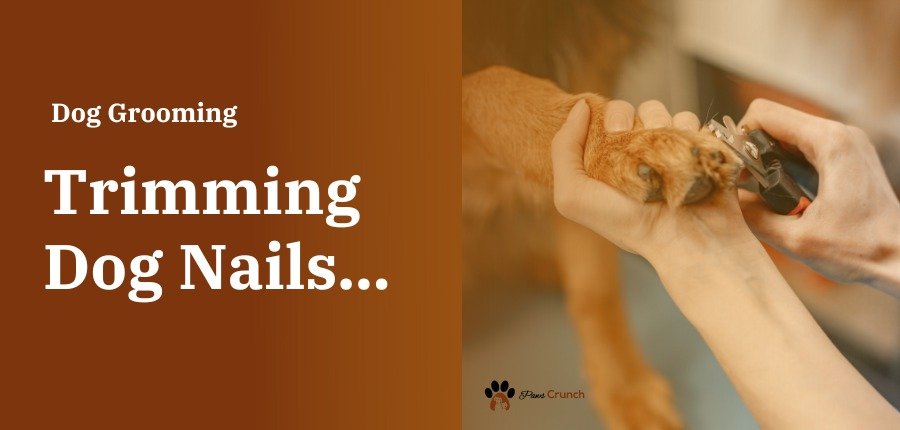How To Trim Dog Nails? 9 Steps Guide
Do your dog’s claws clickety-clack across the floor? Do they get caught on blankets and carpets? It may be time for a trim. There can be problems with mobility and pain associated with long, sharp nails.
But clipping your dog’s nails makes many owners nervous. We’ve all heard tales of hitting the quick or being attacked by anxious pups.
So, how do you trim your dog’s nails?
The key steps for safely and effectively trimming your dog’s nails at home are to properly prepare with high-quality clippers, calm your dog, carefully identify the quick, clip above it in a single motion, file any sharp edges, reward your dog, check the dewclaws, and stop immediately if you hit the quick.
This article will teach you how to prepare tools and dogs, find the quick, position the clippers, and make sessions stress-free for both of you. Follow our step-by-step instructions, and you’ll have happy feet in no time.
How to Trim Your Dog Nails – Step-By-Step


Now, let’s get to clipping those nails. Follow these steps:
Step 1: Sit Or Lay Your Dog On A Comfortable Surface
Choose a spot where they feel relaxed and stable. Small dogs can sit on your lap. Bigger dogs may do better lying down or standing.
Step 2: Hold The Paw Firmly But Gently
Run your hand down their leg and grasp the paw. Spread their toes apart to expose the nails.
Step 3: Identify The Quick
Avoid the quick as it contains nerves and blood vessels. It’s visible in light nails as a pink center. In dark nails, look for a chalky white ring along the bottom.
Step 4: Position The Clippers
Place the nail between the blades above the quick. The safety guard will prevent you from trimming too short.
Step 5: Snip In A Single Motion
Swiftly close the clippers with steady pressure for a clean cut. The edge should now be blunt and even.
Step 6: File Any Sharp Edges
With a nail file, you can smooth the jagged edges left after clipping. Rotating the file also blunts sharp corners.
Step 7: Give A Reward
Immediately praise your dog and offer an enticing treat after each nail to keep them cooperative. Make the experience positive.
Step 8: Check The Dewclaws
Don’t forget to trim the often-forgotten nail located higher up on the inside of the leg.
Step 9: Stop If You See Red
There are small blood vessels in the quick. If you cut into it, apply pressure with styptic powder or a pencil eraser to stop bleeding.
Be aware that the quick recedes as the nail shortens. You can trim a little more each session until the desired length is reached.
How To Choose The Right Nail Clipper?


Investing in high-quality nail clippers designed specifically for dogs is very important for safely and effectively trimming your dog’s nails at home. A good clipper should have the following features:
- Blades that are sharp and precise so you can cut cleanly without splitting nails
- A safety stop guard to reduce the risk of cutting too far and hitting the quick
- Comfortable, ergonomic handles that give you better control and grip when clipping
- A secure lock to keep the blades properly aligned and closed for safe storage when not in use
For beginners, guillotine-style clippers are highly recommended as they are easiest to maneuver. Scissor-style clippers work well for dogs with thick nails. Be sure to choose clippers sized appropriately for your dog’s nails.
While human nail clippers or scissors may seem like an option, nail trimmers designed specifically for dogs are safer and more effective.
Investing in high-quality dog clippers leads to better results and less stress for both you and your pup.
Tricky Nails Problems
Some dogs have nails that are more challenging to trim. Here are solutions for tricky situations:
- Thick nails can be challenging to trim without hitting the quick. Use heavy-duty clippers and only trim small amounts often.
- Clear nails require looking closely to see the pink quickly inside to know where to cut safely. Trim clear nails conservatively.
- Black nails hide the quick, so carefully trim back a small section at a time until the grey ring signaling the end of the quick becomes visible.
- Squirmy, wiggly dogs should be gently restrained by an assistant for a safer, less stressful trim. Go slowly and don’t rush.
- Senior dogs often have overgrown nails with nerves extending close to the ends. Ask your vet to show you where the quick ends are to avoid hitting nerves.
- Severely overgrown nails can be filed down a little each week with a rotary tool until they reach an appropriate length.
When to Seek Professional Help?
The following situations should be left to a professional veterinarian or groomer:
Puppies Under 16 Weeks
Puppies under 16 weeks old have very soft nails that are easy to cut too short. It is best to let a vet or groomer handle trimming on young puppies to avoid any injury.
Anxious or Aggressive Dogs
Dogs that are anxious or aggressive and won’t settle down can be risky to trim at home. Professionals are better equipped to safely restrain and trim nails on dogs that resist.
Severely Overgrown Nails
Severely overgrown nails should be blunted down gradually. Let a groomer handle this process over multiple sessions rather than trying to cut them back too far at once.
Dogs That Resist Restraint
For dogs that strongly resist restraint, it causes undue stress to forcefully hold them for trimming. Professionals have better techniques to keep these dogs calm.
Medical Conditions
There are also some medical conditions that warrant leaving nails to the experts. If a dog has nerve damage, tumors, or other abnormalities of the nails, a vet should assess and trim them.
Conclusion
Nail trimming is essential for your dog’s health and comfort, but many owners are uncomfortable with it. If you prepare the right tools, provide your pup with exercise and treats, find the quick, and clip above it promptly, you will be able to trim those nails at home in no time at all.
Go slow, reward progress, and stop if you see red. With regular, stress-free practice sessions, you’ll both gain confidence in the process. Maintaining proper nail length will prevent painful overgrowth and mobility problems for your pet.
FAQs
When To Trim Your Dog’s Nails?
Trim your dog’s nails every 2-3 weeks for maintenance. Signs it’s time for trim include clicking nails on floors, trouble gripping, nails touching the ground when standing, and curled or twisted nails. Puppies and seniors may need more frequent trims. If you hear clicking or see nails touching, it’s time to trim.
How To Prepare My Dog To Trim Nails?
If your dog seems overly energetic, walk him briskly before trimming. Have treats on hand during the trim to praise and distract them. Work slowly, take breaks, and keep sessions short and positive.
Can I Use A Dremel Tool To Grind Down The Nails?
Yes, a Dremel is safe and effective for gradually filing down overgrown nails as long as you avoid the quick.


